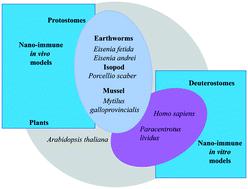当前位置:
X-MOL 学术
›
Environ. Sci.: Nano
›
论文详情
Our official English website, www.x-mol.net, welcomes your
feedback! (Note: you will need to create a separate account there.)
Probing the immune responses to nanoparticles across environmental species. A perspective of the EU Horizon 2020 project PANDORA
Environmental Science: Nano ( IF 5.8 ) Pub Date : 2020-10-14 , DOI: 10.1039/d0en00732c Annalisa Pinsino 1, 2, 3, 4 , Neus G. Bastús 5, 6, 7 , Martí Busquets-Fité 6, 7, 8 , Laura Canesi 4, 9, 10, 11 , Paola Cesaroni 4, 12, 13 , Damjana Drobne 14, 15, 16, 17, 18 , Albert Duschl 19, 20, 21, 22 , Marie-Ann Ewart 23, 24, 25 , Ignasi Gispert 6, 7, 8 , Jutta Horejs-Hoeck 19, 20, 21, 22 , Paola Italiani 2, 4, 26, 27, 28 , Birgit Kemmerling 29, 30, 31, 32 , Peter Kille 25, 33, 34, 35 , Petra Procházková 36, 37, 38 , Victor F. Puntes 5, 6, 7, 39, 40 , David J. Spurgeon 25, 41, 42 , Claus Svendsen 25, 41, 42 , Colin J. Wilde 23, 24, 25 , Diana Boraschi 2, 4, 26, 27, 28
Environmental Science: Nano ( IF 5.8 ) Pub Date : 2020-10-14 , DOI: 10.1039/d0en00732c Annalisa Pinsino 1, 2, 3, 4 , Neus G. Bastús 5, 6, 7 , Martí Busquets-Fité 6, 7, 8 , Laura Canesi 4, 9, 10, 11 , Paola Cesaroni 4, 12, 13 , Damjana Drobne 14, 15, 16, 17, 18 , Albert Duschl 19, 20, 21, 22 , Marie-Ann Ewart 23, 24, 25 , Ignasi Gispert 6, 7, 8 , Jutta Horejs-Hoeck 19, 20, 21, 22 , Paola Italiani 2, 4, 26, 27, 28 , Birgit Kemmerling 29, 30, 31, 32 , Peter Kille 25, 33, 34, 35 , Petra Procházková 36, 37, 38 , Victor F. Puntes 5, 6, 7, 39, 40 , David J. Spurgeon 25, 41, 42 , Claus Svendsen 25, 41, 42 , Colin J. Wilde 23, 24, 25 , Diana Boraschi 2, 4, 26, 27, 28
Affiliation

|
Understanding how engineered nanomaterials affect immune responses of living organisms requires a strong collaborative effort between immunologists, toxicologists, ecologists, physiologists, inorganic chemists, nanomaterial scientists and experts in law and risk management. This perspective aims to provide a new viewpoint on the interaction between engineered nanomaterials and the immune defensive systems across living species, gained within the EU Horizon 2020 project PANDORA. We consider the effects of nanoparticle exposure on immune functions in plants, marine and terrestrial invertebrates and their relation to the current state of knowledge for vertebrates (in particular humans). These studies can shed light on the broader perspective of defensive and homeostatic mechanisms (immunity, inflammation, stress responses, microbiota, stem cell differentiation) suggesting ways to: i) perform a comparative analysis of the nanoparticle impact on immunity across model organisms; ii) inspire best practices in experimental methodologies for nanosafety/nanotoxicity studies; iii) regroup and harmonise fragmented research activities; iv) improve knowledge transfer strategies and nano-security; v) propose innovative tools and realistic solutions, thereby helping in identifying future research needs and tackling their challenges.
中文翻译:

探索对环境物种中的纳米粒子的免疫反应。欧盟Horizon 2020项目PANDORA的观点
要了解工程纳米材料如何影响生物体的免疫反应,需要免疫学家,毒理学家,生态学家,生理学家,无机化学家,纳米材料科学家以及法律和风险管理专家之间的大力合作。该观点旨在为在欧盟地平线2020项目PANDORA中获得的工程纳米材料与整个生命物种的免疫防御系统之间的相互作用提供新的观点。我们考虑了纳米粒子暴露对植物,海洋和陆地无脊椎动物的免疫功能的影响,以及它们与脊椎动物(特别是人类)当前知识状态的关系。这些研究可以为防御和体内平衡机制(免疫,炎症,应激反应,微生物群,干细胞分化)建议采取以下方法:i)对纳米颗粒对模型生物免疫力的影响进行比较分析;ii)激发用于纳米安全性/纳米毒性研究的实验方法的最佳做法;iii)重新组织和统一零散的研究活动;iv)改进知识转移战略和纳米安全;v)提出创新的工具和切合实际的解决方案,从而帮助确定未来的研究需求并应对其挑战。
更新日期:2020-11-03
中文翻译:

探索对环境物种中的纳米粒子的免疫反应。欧盟Horizon 2020项目PANDORA的观点
要了解工程纳米材料如何影响生物体的免疫反应,需要免疫学家,毒理学家,生态学家,生理学家,无机化学家,纳米材料科学家以及法律和风险管理专家之间的大力合作。该观点旨在为在欧盟地平线2020项目PANDORA中获得的工程纳米材料与整个生命物种的免疫防御系统之间的相互作用提供新的观点。我们考虑了纳米粒子暴露对植物,海洋和陆地无脊椎动物的免疫功能的影响,以及它们与脊椎动物(特别是人类)当前知识状态的关系。这些研究可以为防御和体内平衡机制(免疫,炎症,应激反应,微生物群,干细胞分化)建议采取以下方法:i)对纳米颗粒对模型生物免疫力的影响进行比较分析;ii)激发用于纳米安全性/纳米毒性研究的实验方法的最佳做法;iii)重新组织和统一零散的研究活动;iv)改进知识转移战略和纳米安全;v)提出创新的工具和切合实际的解决方案,从而帮助确定未来的研究需求并应对其挑战。











































 京公网安备 11010802027423号
京公网安备 11010802027423号